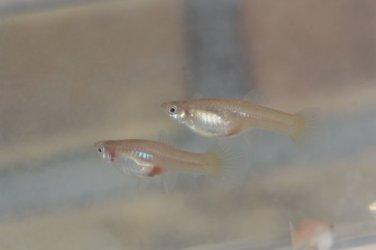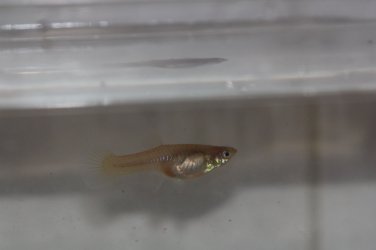There are numerous times that members write that female livebearers are able to store sperm packets. But hardly someone knows how this works. It also seems that not all members know that you can divide livebearers in 2 groups → viviparous and ovoviviparous. Most people overhere just know the ovoviviparous livebearers such as guppies, swordtails, platies, mollies and so on...
Viviparous livebearers have a reproduction method "similar" (so, not exactly but almost the same) to mammals. Most people use "viviparous" with most ovoviviparous livebearers which is of course incorrect. Most viviparous livebearers are hard to find till even none at an average lfs. The ones people find at an lfs are mostly ovoviviparous.
And to those who don't know how those sperm packets are stored in an ovoviviparous livebearer female, I'll give a clarification:
The sperm packets are stored in the folds of the fallopian tube (uterine tube). While the female is having this facility and the used folds are random, you'll never know which sperm packets she will use to fertilize her eggs. So, it could be of an older mating or a recent mating. Is she having a huge number of eggs, multiple sperm packets will be used to cover the number of present eggs. This means that the offspring of one batch could be fathered by 1 or more males. if someone wants to linebreed, this is very important to know. That's why virgin and clean females are so important to use when linebreeding is at hand.
The female is the one which decides if a sperm packet will be used in order to establish a pregnancy. That's why a female is not pregnant at all if she's carrying eggs that are not fertilized yet. And therefore the remark that female guppies (or even other ovoviviparous livebearer females) are always pregnant is incorrect. But I do know where the remark is coming from.
It will also only take a couple of days after fertilization that an embryo has fully developed. The rest of the gestation time (depending on the kind of livebearer between 3-8 weeks) is needed to let the fully developed embryo grow in the egg. The eggs were already provided by the mother with nutrients through follicular epithelia before any fertilization has taken place (this is called pre-fertilization).
Sometimes you're able to watch how a pregnant female that is due that she drops eggs instead of fry. Or eggs and fry. This means that there wasn't sufficient nutrients in the yolk of a number of eggs. Because in normal conditions all eggs have sufficient nutrients in the yolk. Which means also that the embryonic development of all embryos is at the same pace. A situation when a female is stressing a lot, you'll be able to see eggs first coming out for they are smaller and easier to push out. Those eggs just didn't have sufficient nutrients in the yolk. And that has got nothing to do with stress at all. Those eggs would have never developed as being normal embryos starting from the beginning.
The way just fertilized eggs develop untill birth with ovoviviparous livebearers is called lecithotrophy.
The sperm storage ability goes only for ovoviviparous female livebearers that are lecithrophe without superfetation and with superfetation. Superfetation means multiple pregnancies of embryos in different stages of embryonic development. I've written an article about it which will be published in this coming May edition of the "Poecilia news" in the Netherlands.
Viviparous female livebearers which have a placenta are not able to store sperm packets.
Then the max period that ovoviviparous females can store sperm packets. I read so often that it suppose to be a couple of months. This is totally incorrect. Sperm packets can be stored even over a year. So, be careful to say that when a female has been without a male for months and hasn't dropped any fry that she's clean (as it's officially called). She can still carry sperm packets in one of the folds of her uterine tubes if a mating has ever taken place.
And an actual mating does not imply that a fertilization has taken place. It's up to the female to open up 1 or more folds to release 1 or more sperm packets. An actual fertilization will only take place if she's released 1 or more sperm packets.
Hopes this will clarify a little bit...
Viviparous livebearers have a reproduction method "similar" (so, not exactly but almost the same) to mammals. Most people use "viviparous" with most ovoviviparous livebearers which is of course incorrect. Most viviparous livebearers are hard to find till even none at an average lfs. The ones people find at an lfs are mostly ovoviviparous.
And to those who don't know how those sperm packets are stored in an ovoviviparous livebearer female, I'll give a clarification:
The sperm packets are stored in the folds of the fallopian tube (uterine tube). While the female is having this facility and the used folds are random, you'll never know which sperm packets she will use to fertilize her eggs. So, it could be of an older mating or a recent mating. Is she having a huge number of eggs, multiple sperm packets will be used to cover the number of present eggs. This means that the offspring of one batch could be fathered by 1 or more males. if someone wants to linebreed, this is very important to know. That's why virgin and clean females are so important to use when linebreeding is at hand.
The female is the one which decides if a sperm packet will be used in order to establish a pregnancy. That's why a female is not pregnant at all if she's carrying eggs that are not fertilized yet. And therefore the remark that female guppies (or even other ovoviviparous livebearer females) are always pregnant is incorrect. But I do know where the remark is coming from.
It will also only take a couple of days after fertilization that an embryo has fully developed. The rest of the gestation time (depending on the kind of livebearer between 3-8 weeks) is needed to let the fully developed embryo grow in the egg. The eggs were already provided by the mother with nutrients through follicular epithelia before any fertilization has taken place (this is called pre-fertilization).
Sometimes you're able to watch how a pregnant female that is due that she drops eggs instead of fry. Or eggs and fry. This means that there wasn't sufficient nutrients in the yolk of a number of eggs. Because in normal conditions all eggs have sufficient nutrients in the yolk. Which means also that the embryonic development of all embryos is at the same pace. A situation when a female is stressing a lot, you'll be able to see eggs first coming out for they are smaller and easier to push out. Those eggs just didn't have sufficient nutrients in the yolk. And that has got nothing to do with stress at all. Those eggs would have never developed as being normal embryos starting from the beginning.
The way just fertilized eggs develop untill birth with ovoviviparous livebearers is called lecithotrophy.
The sperm storage ability goes only for ovoviviparous female livebearers that are lecithrophe without superfetation and with superfetation. Superfetation means multiple pregnancies of embryos in different stages of embryonic development. I've written an article about it which will be published in this coming May edition of the "Poecilia news" in the Netherlands.
Viviparous female livebearers which have a placenta are not able to store sperm packets.
Then the max period that ovoviviparous females can store sperm packets. I read so often that it suppose to be a couple of months. This is totally incorrect. Sperm packets can be stored even over a year. So, be careful to say that when a female has been without a male for months and hasn't dropped any fry that she's clean (as it's officially called). She can still carry sperm packets in one of the folds of her uterine tubes if a mating has ever taken place.
And an actual mating does not imply that a fertilization has taken place. It's up to the female to open up 1 or more folds to release 1 or more sperm packets. An actual fertilization will only take place if she's released 1 or more sperm packets.
Hopes this will clarify a little bit...
Last edited:





